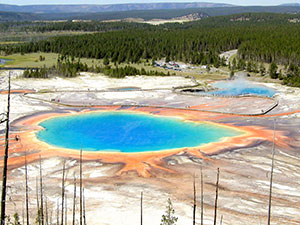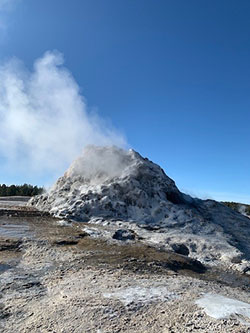
Contact Us
Institutional Communications
Bureau of Mines Building, Room 137
Laramie, WY 82071
Phone: (307) 766-2929
Email: cbaldwin@uwyo.edu
UW Researchers Examine Yellowstone Hydrothermal System in Unprecedented Detail
Published December 07, 2023

The colorful Grand Prismatic Spring in Yellowstone National Park is the park’s
largest and the third-largest spring in the world. Research by UW Professor Ken Sims
and colleagues has provided new insights into Yellowstone’s hydrothermal system. (U.S.
Geological Survey Photo)
University of Wyoming Department of Geology and Geophysics Professor Ken Sims made his mark as a National Geographic Explorer conducting research in some of the world’s most extreme locations, from volcanic lava lakes to the depths of the ocean floor.
In recent years, Sims has put his most intense focus on a wonder of the world located right here in Wyoming: Yellowstone National Park’s amazing hydrothermal system.
As UW’s representative on the U.S. Geological Survey’s Yellowstone Volcano Observatory, Sims has led a comprehensive, multidisciplinary research program studying Yellowstone’s network of 10,000 springs, geysers, fumaroles and mud pots. Some of the team’s findings have been published in Geochimica et Cosmochimica Acta, a peer-reviewed journal sponsored by the Geochemical Society and the Meteorological Society.
In addition to creating a more complete picture of the plumbing in the world’s largest, most profound and visually stunning example of an active continental hydrothermal system, Sims, his graduate students and UW faculty colleagues Andrew Parsekian and Brad Carr aim to increase our understanding of how geological processes below the surface influence what he calls “rock-powered life.”
Sims has dubbed this field of research as “geohydrobiology”: “Geo” means earth, “hydro” means water, and “bio” means life.
“Research into the geohydrobiology of Yellowstone will provide a better understanding of not just the geology and fluids of the hydrothermal system, but also how those fluids impact the diverse microorganisms that lend Yellowstone’s thermal features their spectacular forms and colors,” Sims says. “Yellowstone is a place where earth, water and life intersect in unusual and stunning ways, and it’s a natural laboratory to study those connections. Or, as Alexander von Humboldt so profoundly noted about nature in 1863 in his journal Cosmos, ‘All things are interconnected.’
“Essentially, geological processes enable rock-powered or chemotrophic life and, in turn, chemotrophic life influences the chemistry of Yellowstone’s fluids and even its landscape evolution,” Sims adds. “Furthermore, these same processes have been going on since Earth’s earliest history; and, in fact, it is likely that it was in hydrothermal systems, much like Yellowstone’s, where life on Earth began.”
Plumbing in Yellowstone
Yellowstone’s surface hydrothermal features are tied to a reservoir deep underground that is heated by volcanic activity and recharged by rain and meltwater from high elevations. These fluids descend into the earth, are super-heated and pick up new chemicals, such as chloride and sulfur, from the volcanic gases. The chemically enriched hot waters then rise back up to the surface to form Yellowstone’s iconic thermal features.
Sims explains that, during its ascent to the surface, the super-heated water boils as pressure decreases. This boiling results in what is known as “phase separation,” in which the vapor and liquid separate and migrate to the surface along different paths. Sort of like boiling a teapot, the water separates into two phases -- hot liquid water and water vapor/steam. However, in Yellowstone, the hydrothermal fluids rising from deep are more complex and carry chloride and sulfur compounds.

White Dome Geyser in Yellowstone’s Lower Geyser Basin is another feature of the
park’s hydrothermal system. UW Professor Ken Sims, who leads a research project under
two Yellowstone National Park research permits, took this photo from Firehole Lake
Drive in the park. (Ken Sims Photo)
When these hot Yellowstone fluids rise from deep and boil, the liquid phase -- which is neutral to basic in pH, or the potential of hydrogen -- retains most of the chloride. In contrast, the complementary vapor phase contains the sulfur compounds, which stay with the steam. Then, when this sulfur-rich water vapor mixes with shallow oxidizing groundwater, a series of chemical reactions occurs. Importantly, these chemical reactions involve sulfur-metabolizing bacteria, which is what ultimately makes some of Yellowstone’s hot springs acidic.
It is this phase separation process that makes Yellowstone waters have a remarkable bimodal distribution of pH. Of course, nothing is simple, as these phase-separated water and vapors mix with colder ground and surface water as they ascend, further influencing their composition.
This phenomenon not only explains the bimodal distribution of the water’s pH, but it also helps explain the stunning diversity of Yellowstone’s hydrothermal fluids, with temperatures reaching nearly 200 degrees Fahrenheit, the temperature of boiling water at Yellowstone’s elevation.
“While phase separation can explain much of the chemical variation seen in Yellowstone’s hydrothermal fluids, our understanding of this important process has been severely limited by our lack of knowledge of the shallow plumbing of Yellowstone’s hydrothermal features -- and the time scales over which the phase separation takes place,” Sims says. “In essence, we have had a two-dimensional understanding of a four-dimensional problem. We knew surface geometry, water chemistry, heat flow and the microbiology for many of the thermal features, but we didn’t understand the ultimate composition of the deep hydrothermal reservoir. Nor did we know the timing and pathways for ascent of the fluids coming from deep.”
To create a four-dimensional picture, Sims, his graduate students and his colleagues:
-- Used geophysical tools -- such as electromagnetics, ground-penetrating radar, nuclear magnetic resonance and seismic refraction -- to obtain an image of the subsurface plumbing of hydrothermal features.
-- Measured the chemistry of the fluids’ radioactive isotopes that change in composition over time. These measurements were conducted both in the field and in Sims’ world-class isotope lab, which he established when he moved to UW in 2009. These isotopic measurements, which have half-lives ranging from one minute to 108 billion years, serve as little “clocks in the rocks and fluids” to better establish the nature of the deep-source reservoir, the timing of interactions between water and rock and the ages of the fluids.
-- And, finally, worked with Montana State University microbiologists Eric Boyd and Dan Colman to measure the DNA and metabolic processes of microbial life in Yellowstone’s hot springs.
Sims, his students and colleagues bring all of the disciplines together to understand the causative links between subsurface geological processes, the development of geochemical fluids, and the assembly and diversification of thermophilic microbial communities in hydrothermal systems.
Sims’ Yellowstone research was conducted under two Yellowstone National Park research permits -- Geophysics Yell 6090 (Sims) and Geochemistry Yell 5840 (Sims).
Contact Us
Institutional Communications
Bureau of Mines Building, Room 137
Laramie, WY 82071
Phone: (307) 766-2929
Email: cbaldwin@uwyo.edu
